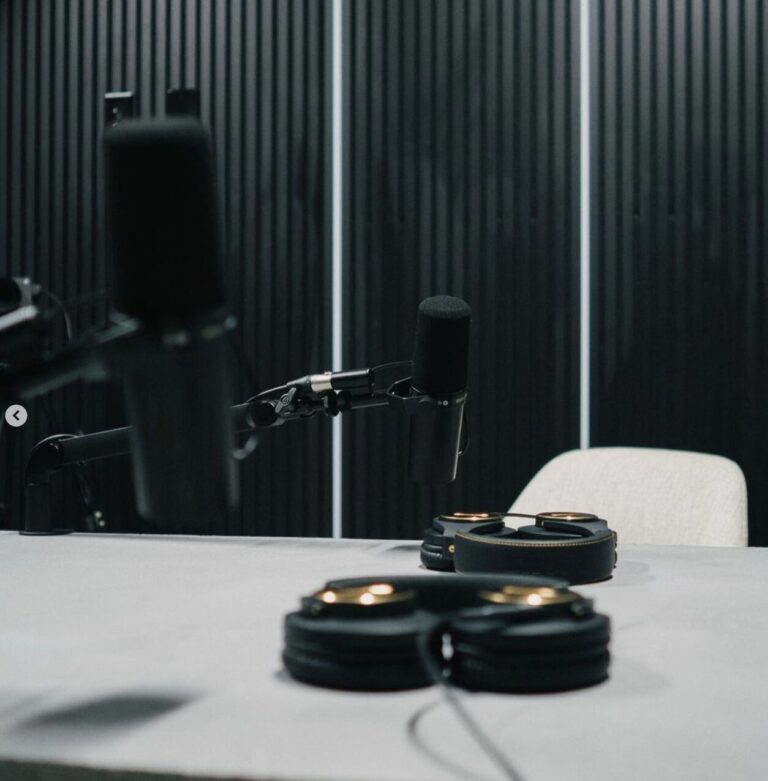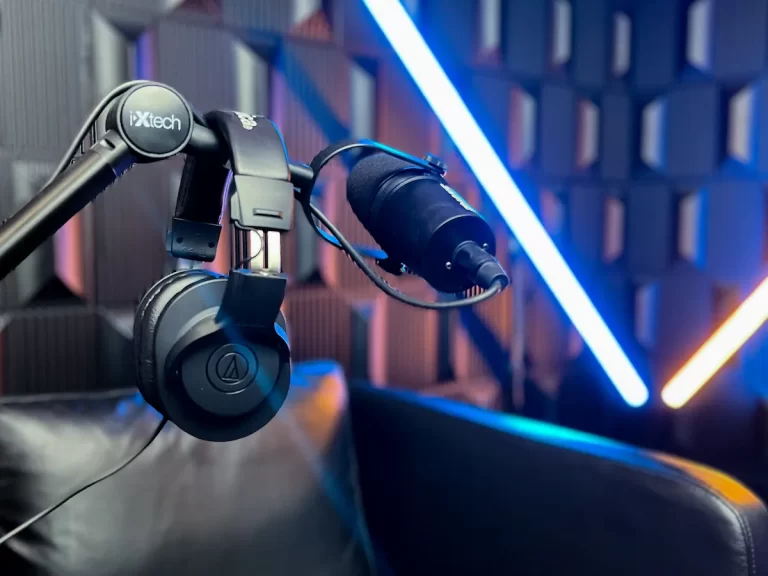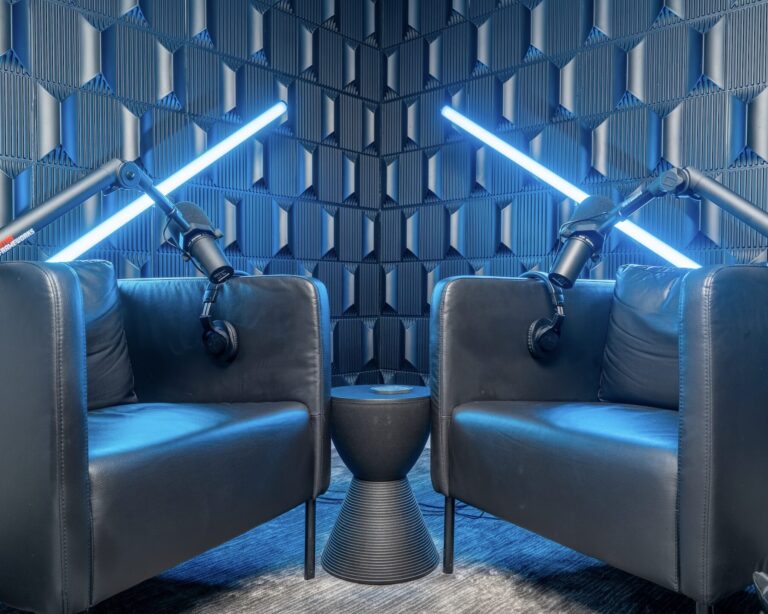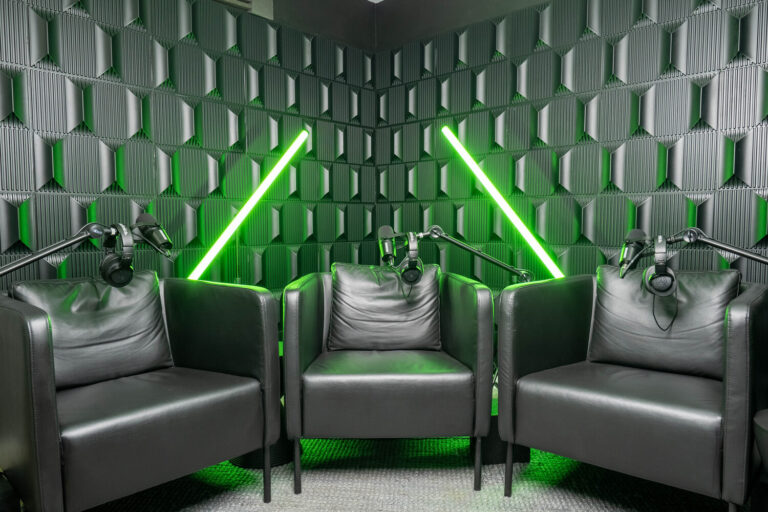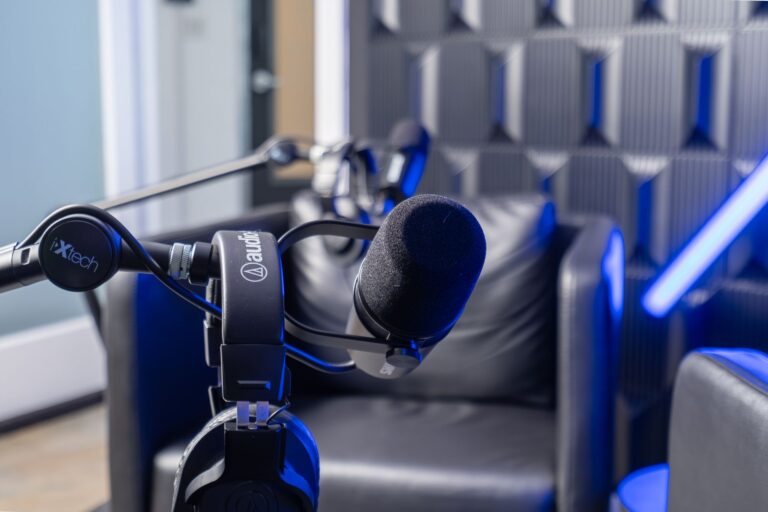Building Your Own Podcast Studio: Essential Equipment and Tips to Get Started
Oh, the world of podcasting. It seems like everyone has a podcast these days, from celebrities dishing out their advice to comedians making us laugh on our morning commute.
The beauty of this medium is that anyone can create their own show, providing a platform for diverse voices and perspectives. But what does it take to set up a professional-sounding podcast studio? It may seem daunting, but fear not, aspiring podcaster.
With some tips and tricks, you can transform your spare room or basement into a space that will have listeners tuning in time and time again. So, grab your headphones, mic, and a notepad, as we delve into the world of what’s needed to turn your podcast dreams into reality.
Here are our top tips for building a podcast studio that will generate high-quality audio and leave your audiences listening intently to your every word.
Are you thinking about starting your own podcast? Do you want to take your content creation game to the next level? Well, you’re in luck! Tips to build your own podcast studio can help achieve your goals. Creating a podcast can be incredibly fun, rewarding, and enlightening, but it can be challenging.
Whether you’re a seasoned podcaster or just starting, building a podcast studio is one of the most essential steps to creating high-quality content. But what exactly do you need to get started? Building a podcast studio requires both the essential equipment and some helpful tips to ensure success.
It can challenging and time-consuming to figure out everything you need, but it’s also crucial to choose the right equipment for your goals and budget. From microphones to headphones, from soundproofing to mixing boards, the list of equipment can be overwhelming.
But don’t fret, we’ve got you covered. This article will take you through everything you need to know about building a podcast studio, so you can create content that is informative, entertaining, and engaging.
Get ready to delve into tips for building a podcast studio and start creating some quality content!
Book Your Next Project With Us
Boost your creative process at Media Pouch Studios – your all-in-one hub for creation and growth
Intro to Podcasting
From the early days of radio broadcasting to the current multimedia landscape, audio content dubbed as podcasts have come a long way. Podcasting no longer remains within the purview of radio stations or big production houses.
Anyone with the right equipment and right mindset can create a podcast. With an ever-growing audience and increasing appetite for various niches, it’s an excellent time to jump on the podcasting bandwagon.
All you need is some basic knowledge, the right space, and the essential podcasting equipment for beginners, which we’ll be discussing in this article section. Starting from scratch, it’s an intricate process to set up a podcast studio from the ground up.
The essential equipment to get started is microphones, headphones, and a mixer. The microphone acts as the gateway to your audience’s ears, whereas the headphones are significant in monitoring the podcast’s quality throughout recording.
The mixer is the tool for blending different elements like sound effects, intro music, or pre-recorded sounds to achieve the desired final product. Other bells and whistles, such as sound-proofing material or an external recorder, can take you from beginners to professionals.
However, equipment alone isn’t enough to make your podcast unique. Your content should be engaging, relevant, and informative for your audience.
You can either have a solo podcast, where you share your views, or host guests and cultivate interview skills. Once you’ve got the equipment and content right, it’s crucial to plan and distribute your content on the right platforms, be it Apple Podcast, Spotify, or Google Podcasts.
Podcasting equipment for beginners is an essential aspect but doesn’t overburden yourself with the upfront investment. Start small, learn from your experiences, and experiment.
Stay patient, persistent and focused. Remember, the ultimate goal is to have a podcast that not only sounds professional, but is also personal and authentic to you, your brand, and your audience.
Designing Your Studio Setup
With podcasting’s rapid growth in popularity, it’s no surprise that people are wanting to create their own content in their own creative spaces. Podcasting is the perfect opportunity to showcase your voice and opinions, and with the right equipment, it can sound professional and engaging.
But how do you get started with your own podcast recording studio? One of the most important aspects of setting up your studio is designing its layout. Your podcast studio’s layout should be effective for sound quality and accommodate all the equipment you need.
Reduce reverberation and external noise by using curtains, carpets, and other sound-absorbing materials to create a cozy recording area. When it comes to equipment, start with a good quality microphone and headphones.
Microphones can range in prices and choosing the right one can greatly improve the quality of your recordings. Headphones are important to monitor your sound and catch any inconsistencies.
Other essential equipment includes an audio interface, a computer, editing software, and possibly a mixer. Don’t forget to test your equipment before you fully launch your podcast.
Try out different settings and record some practice episodes. Lastly, use these podcast recording tips to enhance your podcast: be confident and have fun, select engaging topics, conduct pre-show research and preparation, always be mindful of your tone, and be consistent with your release schedule.
Microphones and Headphones
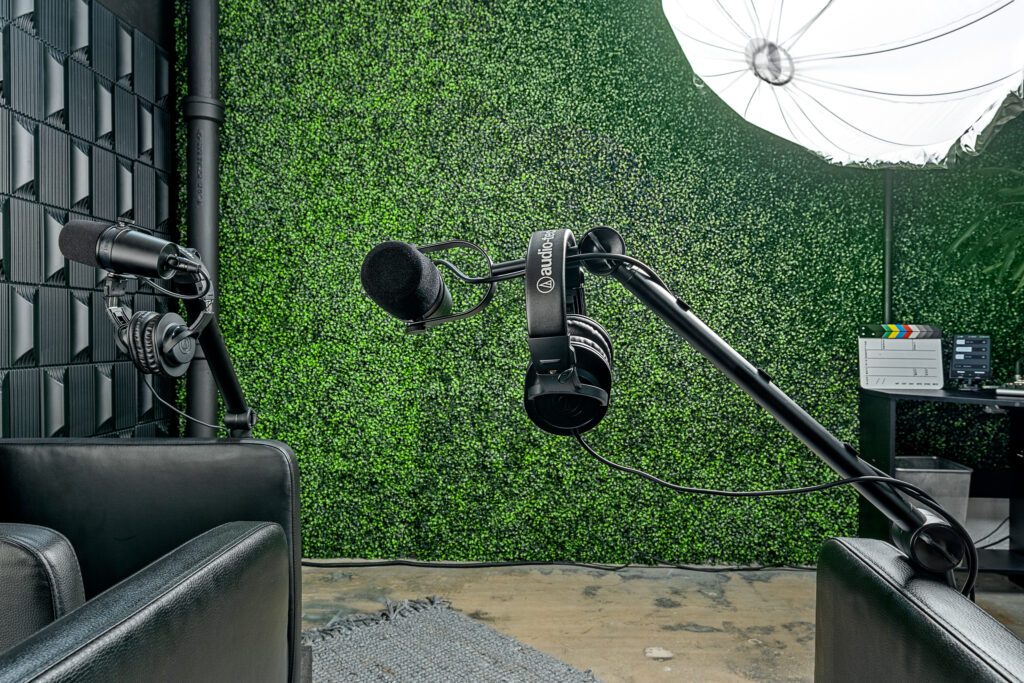
If you’re considering starting your own podcast, investing in quality microphones and headphones is key to producing professional, engaging content. Podcast studio essentials include condenser microphones, dynamic microphones, and closed-back headphones.
Condenser microphones are sensitive and pick up a wide range of frequencies, making them ideal for capturing natural-sounding vocals and music. Dynamic microphones, on the other hand, are more rugged and better equipped to handle louder or more intense recordings like live interviews or concerts.
Closed-back headphones block out external sounds and prevent audio feedback, giving you better control over your recording. However, open-back headphones may be preferable if you want to maintain natural acoustics and hear your voice in the room.
When shopping for podcast studio essentials, make sure to consider your own unique needs and preferences. Some podcasters prefer to use USB microphones, which plug directly into a computer, while others opt for XLR microphones, which require an audio interface or mixer.
Additionally, headphones come in a wide range of shapes and sizes, so try on a few different pairs to find the most comfortable fit. Other factors to consider when choosing microphones and headphones include frequency response, sensitivity, and impedance.
Ultimately, the right equipment can make all the difference in your podcast production. Whether you’re just starting out or looking to upgrade your existing setup, investing in high-quality microphones and headphones will help you create engaging, captivating content that keeps your audience coming back for more.
So, take the time to research and experiment with different options, and don’t be afraid to invest in the podcast studio essentials that will help you tell your story in the most compelling way possible.
Audio Interfaces and Mixers
Whether you’re a seasoned podcaster or just starting out, deciding on the essential podcasting equipment can be a daunting task. Audio interfaces and mixers are a critical component of any successful podcast studio, delivering high-quality sound that captivates your audience.
But with so many options to choose from, it’s easy to get overwhelmed. For example, a basic USB audio interface is perfect for beginners who don’t need complex sound routing or multiple microphone inputs.
On the other hand, a mixer is an all-in-one solution that is ideal when recording with multiple microphones or recording live events. Mixers also give you full control over the sound, allowing you to adjust levels, EQ, and effects on the fly.
But which one to choose?
The answer depends on how you plan to use it and what your budget is. Some popular options include the Focusrite Scarlett 2i2, PreSonus AudioBox, and the Behringer Xenyx Q802USB.
Whichever you decide on, be sure to do your research and read reviews from other podcasters. Remember, your audio quality can make or break your podcast, so investing in high-quality equipment is essential.
Digital Audio Workstations (DAW)
If you’re serious about building your own podcast studio, you’ll want to familiarize yourself with digital audio workstations (DAWs). These software programs are essential for recording, editing, and producing your podcasts with professional-level quality.
DAWs can seem overwhelming at first, with their complex interfaces and array of features, but with some patience and experimentation, you can master them. One popular DAW is Pro Tools, which is used widely in the music and broadcast industries.
It offers powerful editing tools, plugins for sound effects and mixing, and the ability to work with multiple tracks simultaneously. Another widely used DAW is Audacity, which is free and open-source.
Despite its lack of advanced features, Audacity is a reliable option for beginners or those on a budget. Regardless of which DAW you choose, you’ll need some equipment for podcasting to get started.
This can include a microphone, headphones, a mixing console, an audio interface, and a computer. Keep in mind that quality equipment can make a huge difference in the final sound of your podcast, so consider investing in higher-end gear if you have the budget for it.
In addition to hardware, you’ll also want to think about creating a comfortable and acoustically treated recording space. Good luck on your podcasting journey – with the right tools and some practice, you’ll be producing top-notch content in no time!
Acoustic Treatment for Your Space
As you embark on your podcasting journey, you may find yourself consumed with choosing the right podcast recording equipment. But don’t forget about the importance of acoustic treatment for your space.
No matter how advanced your microphone or mixer is, if you’re recording in a space with poor acoustics, your audio quality will suffer. So, where do you start? First, consider the size and shape of your room.
Is it square, rectangular, or oddly shaped? This will determine how sound waves bounce around in the space. You’ll need to add acoustic treatments, such as absorption panels or diffusers, to minimize reflections and create a more controlled sound environment.
But be careful not to over-treat your space, as too much absorption can create a dead-sounding room. Next, think about your podcasting setup.
Are you recording solo or with guests? Will you be standing or sitting? This will determine where you place your treatments and how many you’ll need. Finally, don’t forget about the floor and ceiling.
Carpeting, rugs, and suspended ceilings can also help improve acoustics. By taking the time to properly treat your space, you’ll be on your way to producing high-quality audio content that your listeners will love.
Accessories and Additional Gear
Are you finally ready to take the plunge and create your own podcast studio? You’ve got the perfect topic picked out, the equipment you need has been chosen, and now you’re looking for some additional gear to take your podcast to the next level. Lucky for you, the world of podcasting gear is vast and varied, with tons of options to suit every budget and preference.
First things first, let’s talk about microphones. While you may have already purchased a microphone for your studio, it’s important to consider investing in a pop filter as well.
This simple accessory can make a world of difference in reducing plosives and other problematic sounds that can detract from the overall quality of your recording. Next up, headphones.
While you can certainly use any pair of headphones you have lying around, investing in a pair specifically designed for podcasting can elevate your production value. Look for headphones with a closed-back design to minimize bleed from your microphone and a frequency response tailored to the human voice.
Other accessories to consider include a shock mount for your microphone, which can reduce handling noise and other unwanted sounds picked up by your mic, and a boom arm to position your mic exactly where you need it for optimal sound quality. Of course, this is just the tip of the iceberg.
There are a plethora of other accessories and additional gear you may want to add to your podcasting gear list, from audio interfaces and sound panels to editing software and music libraries. Whatever your needs and budget may be, remember that investing in high-quality gear can make all the difference in creating a podcast that truly stands out.
So go ahead, start building your dream podcast studio and see where it takes you!
Book Your Next Project With Us
Boost your creative process at Media Pouch Studios – your all-in-one hub for creation and growth
Launching Your Podcast and Beyond
Are you thinking about starting your own podcast? Well, you’re not alone. With nearly a million active podcasts on the market today, it’s clear that more and more people are gravitating towards the format.
Whether you’re considering podcasting as a hobby, a side gig, or even a full-time job, one of the most important things you can do is to create a professional recording environment. Having a dedicated podcast studio is the key to creating high-quality audio content that will engage and inspire your audience.
But what exactly do you need to build a podcast studio? Firstly, it’s important to consider the space you will use. Creating a soundproof environment is key; try to find a windowless room that you can designate solely for recording.
You will also need a computer or laptop, microphone, and good headphones. The microphone is perhaps the most important piece of equipment for podcasters.
A good-quality microphone will ensure that your audio is clear and crisp. Be sure to invest in a pop filter, which will help eliminate any unwanted popping and hissing sounds.
When it comes to software, there are numerous options out there. Many podcasters use Audacity or GarageBand, as they are free and easy to use.
As you gain experience, you may want to invest in more advanced audio editing software, such as Adobe Audition. In addition to the equipment and software, there are several other important factors to consider.
For example, it’s essential to create a content strategy for your podcast. Who is your target audience? What topics will you cover? How often will you release episodes? These are all important questions to ask yourself before launching your podcast.
Finally, don’t forget about promotion! Once your podcast is live, you will need to market it to your target audience. Use social media, paid advertising, and email marketing to get the word out.
Consider collaborating with other podcasters in your niche or bringing on guest speakers to help expand your reach. Starting a podcast can be an exciting and rewarding experience, but it’s important to do it right.
By following these tips for building a podcast studio, you’ll be well on your way to creating high-quality audio content that will engage and inspire your audience. So what are you waiting for? Get recording!
The Long and Short of It
So, there you have it – the essential items required to set up a podcast studio. It may seem like a simple list, but the devil is in the details.
Each of these items needs careful consideration, from which microphone suits your voice to the type of soundproofing foam that’s right for your space – the process can be overwhelming. But, like any creative endeavor, it’s all about finding what works for you.
Not everyone needs an expensive mixer, and not every tiny closet needs to be soundproofed to a professional level. Your goals and budget will dictate the type of podcasting setup you need, but the key takeaway is that with some dedication, creativity, and resourcefulness, anyone can set up a podcast studio at home.
In an age where anyone can create content, it’s exciting to think about the possibilities that open up when people start telling their own stories. Who knows – maybe your podcast will be the next big hit? Regardless, it’s worth taking the leap to set up your own studio and start sharing your perspectives with the world.
Happy podcasting!


